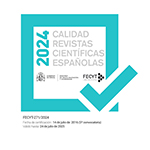Creer para ver. Instauración del discurso milagroso entre la población del Nuevo Reino de Granada, siglos XVI, XVII y XVIII
Résumé
El artículo analiza la instauración discursiva del milagro en la sensibilidad religiosa de la población del Nuevo Reino de Granada, colonia americana del Imperio español, con sede en Santafé de Bogotá, durante los siglos XVI, XVII y XVIII. Se recurrió a la identificación de sucesos milagrosos tanto en el territorio (ciudades, villas y pueblos de indios de la parte central del NRG) como a los relatos y descripciones que de ellos se hacía en las relaciones o diarios de viaje escritos por clérigos de diferentes órdenes regulares y seculares y se realizó una tipología de los hechos identificados. La metodología se orientó desde tres miradas de los milagros: la construcción discursiva desde la apropiación social de estos fenómenos, la aceptación popular de un hecho inesperado y la configuración simbólica que estos tuvieron en los procesos de cohesión social entre esta y otras provincias del territorio neogranadino; asimismo, se identificaron cuatro categorías de milagros: los de una imagen sobre sí misma, de asistencia, físicos y taumatúrgicos; estos, a su vez, se agruparon como impersonales, individuales o colectivos.Téléchargements
##submission.format##
Licence
La revista 'Ilu. Revista de Ciencias de las Religiones, para fomentar el intercambio global del conocimiento, facilita el acceso sin restricciones a sus contenidos desde el momento de su publicación en la presente edición electrónica, y por eso es una revista de acceso abierto. Los originales publicados en esta revista son propiedad de la Universidad Complutense de Madrid y es obligatorio citar su procedencia en cualquier reproducción total o parcial. Todos los contenidos se distribuyen bajo una licencia de uso y distribución Creative Commons Reconocimiento 4.0 (CC BY 4.0). Esta circunstancia ha de hacerse constar expresamente de esta forma cuando sea necesario. Puede consultar la versión informativa y el texto legal de la licencia.











